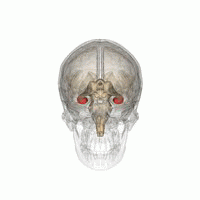
Subicular pyramidal neurons gate drug resistance in temporal lobe epilepsy
Sign Up to like & getrecommendations! Published in 2019 at "Annals of Neurology"
DOI: 10.1002/ana.25554
Abstract: Drug‐resistant epilepsy causes great clinical danger and still lacks effective treatments. read more here.
Keywords: epilepsy; subicular pyramidal; pyramidal neurons; drug ... See more keywords

Facial nerve axotomy induces morphological changes in hippocampal pyramidal neurons
Sign Up to like & getrecommendations! Published in 2023 at "Journal of Comparative Neurology"
DOI: 10.1002/cne.25455
Abstract: Facial nerve injury in rats have been widely used to study functional and structural changes that occur in the injured motoneurons and other central nervous system structures related with sensorimotor processing. A decrease in long‐term… read more here.
Keywords: pyramidal neurons; facial nerve; ca1; nerve ... See more keywords

Integrin β3 regulates apical dendritic morphology of pyramidal neurons throughout hippocampal CA3.
Sign Up to like & getrecommendations! Published in 2023 at "Hippocampus"
DOI: 10.1002/hipo.23530
Abstract: In excitatory hippocampal pyramidal neurons, integrin β3 is critical for synaptic maturation and plasticity in vitro. Itgb3 is a potential autism susceptibility gene that regulates dendritic morphology in the cerebral cortex in a cell-specific manner.… read more here.
Keywords: pyramidal neurons; morphology; itgb3; apical dendritic ... See more keywords

Transient receptor potential vanilloid 4 activation inhibits the delayed rectifier potassium channels in hippocampal pyramidal neurons: An implication in pathological changes following pilocarpine‐induced status epilepticus
Sign Up to like & getrecommendations! Published in 2020 at "Journal of Neuroscience Research"
DOI: 10.1002/jnr.24749
Abstract: Activation of transient receptor potential vanilloid 4 (TRPV4) can increase hippocampal neuronal excitability. TRPV4 has been reported to be involved in the pathogenesis of epilepsy. Voltage‐gated potassium channels (VGPCs) play an important role in regulating… read more here.
Keywords: receptor potential; pyramidal neurons; hippocampal pyramidal; transient receptor ... See more keywords

Effects of Acute Alcohol Exposure on Layer 5 Pyramidal Neurons of Juvenile Mice
Sign Up to like & getrecommendations! Published in 2017 at "Cellular and Molecular Neurobiology"
DOI: 10.1007/s10571-017-0571-4
Abstract: Early-onset drinking during childhood or preadolescence is a serious social problem. Yet, most of the basic neurobiological research on the acute effects of ethanol has been carried out on adult or early postnatal animals. We… read more here.
Keywords: alcohol exposure; exposure; pyramidal neurons; layer pyramidal ... See more keywords

Neuroligins Differentially Mediate Subtype-Specific Synapse Formation in Pyramidal Neurons and Interneurons
Sign Up to like & getrecommendations! Published in 2019 at "Neuroscience Bulletin"
DOI: 10.1007/s12264-019-00347-y
Abstract: Neuroligins (NLs) are postsynaptic cell-adhesion proteins that play important roles in synapse formation and the excitatory-inhibitory balance. They have been associated with autism in both human genetic and animal model studies, and affect synaptic connections… read more here.
Keywords: subtype specific; pyramidal neurons; synapse formation; formation ... See more keywords

Subicular Pyramidal Neurons: A Key to Unlock the “Black Box” of Drug Resistance in Temporal Lobe Epilepsy
Sign Up to like & getrecommendations! Published in 2019 at "Neuroscience Bulletin"
DOI: 10.1007/s12264-019-00440-2
Abstract: Drug resistance is one of the most serious issues in epilepsy. Despite using various appropriate anti-epileptic drugs (AEDs), 30% of epilepsy patients are still drugresistant. The percentage of resistance in temporal lobe epilepsy (TLE) is… read more here.
Keywords: drug resistance; subicular pyramidal; epilepsy; pyramidal neurons ... See more keywords

Layer 2/3 Pyramidal Neurons Control the Gain of Cortical Output.
Sign Up to like & getrecommendations! Published in 2018 at "Cell reports"
DOI: 10.1016/j.celrep.2018.08.038
Abstract: Initial anatomical and physiological studies suggested that sensory information relayed from the periphery by the thalamus is serially processed in primary sensory cortical areas. It is thought to propagate from layer 4 (L4) up to… read more here.
Keywords: layer; layer pyramidal; pyramidal neurons; output ... See more keywords

Distinct in vivo dynamics of excitatory synapses onto cortical pyramidal neurons and parvalbumin-positive interneurons.
Sign Up to like & getrecommendations! Published in 2021 at "Cell reports"
DOI: 10.1016/j.celrep.2021.109972
Abstract: Cortical function relies on the balanced activation of excitatory and inhibitory neurons. However, little is known about the organization and dynamics of shaft excitatory synapses onto cortical inhibitory interneurons. Here, we use the excitatory postsynaptic… read more here.
Keywords: onto cortical; pyramidal neurons; parvalbumin positive; synapses onto ... See more keywords

P135 Intermittent theta burst increases action potential threshold and spike firing in cortical layer 5 pyramidal neurons
Sign Up to like & getrecommendations! Published in 2017 at "Clinical Neurophysiology"
DOI: 10.1016/j.clinph.2016.10.257
Abstract: Introduction Repetitive transcranial magnetic stimulation has become a popular method of inducing neural plasticity in humans. In particular, complex patterned stimulation such as intermittent theta burst stimulation (iTBS) is routinely used to increase corticospinal excitably.… read more here.
Keywords: itbs; layer pyramidal; pyramidal neurons; spike firing ... See more keywords

Selective postnatal excitation of neocortical pyramidal neurons results in distinctive behavioral and circuit deficits in adulthood
Sign Up to like & getrecommendations! Published in 2021 at "iScience"
DOI: 10.1016/j.isci.2021.102157
Abstract: Summary In genetic and pharmacological models of neurodevelopmental disorders, and human data, neural activity is altered within the developing neocortical network. This commonality begs the question of whether early enhancement in excitation might be a… read more here.
Keywords: postnatal excitation; selective postnatal; pyramidal neurons; circuit ... See more keywords